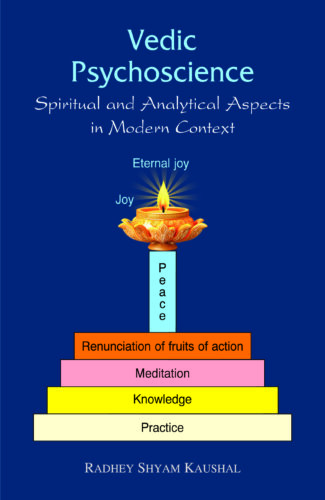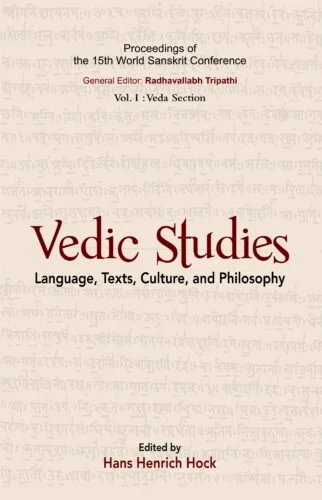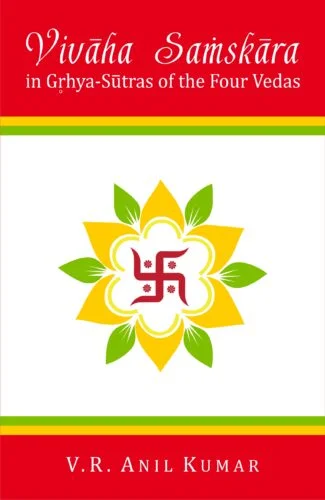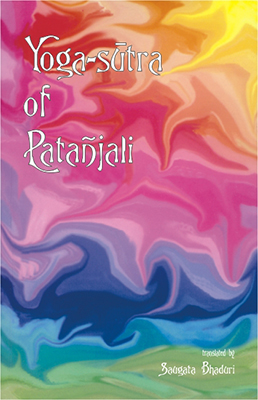Showing 157–166 of 166 results

This book is a scholarly attempt to develop “psychoscience” in the light of Vedic wisdom. It initiates to give deeper foundations to various aspects of Vedic wisdom in the spirit of modern science using analogies from modern science, demonstrating the eternity and universality of some aspects of Vedic concepts.
“This book is a scholarly attempt to develop “psychoscience” in the light of Vedic wisdom. It initiates to give deeper foundations to various aspects of Vedic wisdom in the spirit of modern science using analogies from modern science, demonstrating the eternity and universality of some aspects of Vedic concepts. It is targeted to encourage young scientific minds to explore further the theoretical developments and applications in the fields of personality development and behavioural science. It, further, descriptively discusses the experience of absolute reality in Nature in terms of three basic aspects: perception at gross-body level; rational thinking at micro-body level; and realization at causal-body level.
The volume is divided into three parts. Part 1 accounts for the link of psychoscience with causal existence, basically dealing with the art of enlightenment of an individual. Part 2 addresses the foundations of psychoscience. Part 3 focuses on the behavioural and application aspects of psychoscience.
The book, written in an objective and non-sermon style, addresses a wide gamut of readers such as physicists, chemists, brain-scientists, psychologists, philosophers and philosophers of science with some scientific temper, at times employing convenient mathematical methods and justifying the universality and eternity of inherent truths.”

This volume contains scholarly papers from the Veda Sessions of the 15th World Sanskrit Conference, touching a broad spectrum of the Vedic tradition and focusing on three major aspects of that tradition: language and linguistics; textual criticism and text edition; and culture, philosophy, mythology.
The Vedas hold a position of prominence, both as the oldest documents of Sanskrit and as the most venerable texts of Hinduism.
This volume contains scholarly papers from the Veda Sessions of the 15th World Sanskrit Conference, touching a broad spectrum of the Vedic tradition and focusing on three major aspects of that tradition: language and linguistics; textual criticism and text edition; and culture, philosophy, mythology.
Language and linguistics papers range from syntax and semantics (Hock, Küummel) to morphology (Tucker), onomastics (Pinault) and rhetorical structure (Klein). Remarkably, three of the articles in the second part deal with the tradition of Atharvaveda (Bahulkar, Kulkarni, and Rotaru and Sumant); the remaining two focus on Rigveda (Khare and Köhler). Two papers in the last part deal with matters of Vedic philosophy (Benedetti and Vedi), one is devoted to mythology and ritual (Gadgil), and one addresses ritual and material culture (Nishimura).

Of a rare kind, this book does comparative analyses after studying seventeen Grhya-Sutras across four Vedas of the number and type of rituals of marriage in each Grhya-Sutra and the order of performance of rituals. It also lists the mantras (with English translation) and their sources and talks about the differences in employing the mantras.
Vivaha (marriage), in Hindu society, is one of the most important samskaras, out of the sixteen sacraments, which a person steps in with full understanding/consciousness. Marriage is a fascinating experience that stays alive in ones mind throughout the life. The mantras and slokas of the Grhya-Sutras of the four Vedas, chanted in this ritual, are in Sanskrit and a vast majority is unaware of their meanings and just follows the instructions of the celebrant priest, purohita.
The author delves deep into the Grhya-Sutras of Vedas and brings forth the details of vivaha samskara principles, philosophy, practices, rituals and so on. Grhya-Sutras Asvalayana, Sankhayana and Kausitaki of Rigveda; Paraskara (Sukhla Yajurveda), Apastamba and Hiranyakesin (Krsna Yajurveda), Baudhayana, Varaha, Manava, Agnivesya, Bharadvaja, Kathaka and Vaikhanasa of Yajurveda; Gobhila, Khadira and Jaimini of Samaveda; and Kausika of Atharvaveda are well explored and seriously analysed, having given the original mantras in Sanskrit with their English translation.
Of a rare kind, this book does comparative analyses of the number and type of rituals in each Grhya-Sutra and the order of performance of rituals.
This scholarly work creates a sudden seriousness and sanctity to vivaha samskara through the detailing of mantras and the rituals. Being in it, one is not far off the Vedic period, giving a new meaning and dimension to our understanding of Hindu vivaha samskara and its sanctity.

Vyangyavyakhya (interpretation of implied sense), ninth century, is the first performance text in Sanskrit applying dhvani to Bharata’s theatre. The author Kulasekhara deserves a place next to Anandavardhana and Abhinavagupta in the history of Natyasastra studies. The text is published for the first time.
The doctrine of dhvani, expounded by Anandavardhana (ninth century ce) in Kashmir though contested by his contemporaries at home, received sound acclamation in Kerala. A royal dramatist Kulashekhara of the same century applied dhvani to the theatre. His performance text is known as Vyangyavyakhya (VV), meaning interpreting the implied. This was an epoch-making event in the history of Indian theatre. This innovation in performative practices marked a deviation from Bharatas national tradition and laid down the foundation for classical forms like Kutiyattam, Kgrshnanattam, Kathakali and Mohiniyattam. VV today continues to inspire contemporary directors to formulate new interpretative sub-texts for ancient plays. VV, which remained in manuscripts till now, is published for the first time.
As icing on the cake, four eminent scholars K.D. Tripathy, Radhavallabh Tripathi, N.P. Unni and Kavalam Narayana Panikkar delve deep into the aspects of VV as introduction to this book. This volume discusses in detail the Sanskrit theatre until tenth century ce, performance texts of Dhananjayadhvani and Samvaranadhvani, and the developments in the post-Kulashekhara era.
VV should serve as a guide to all practitioners of performing arts, and should entice students, teachers and lovers of Indian performing arts.

The English translation of Yoga-sutra adopts a unique approach: it retains many Sanskrit technical terms to present their inadequate rendering in English and avoids elaborate commentaries. It examines Yoga philosophy in relation to other orthodox philosophical system and analyses issues of cognition and signification.
Patanjali’s Yoga-sutra, one of the most well-known works in the Indian classical tradition, is recognised as the primary text of Yoga philosophy. Here, Dr. Bhaduri adopts a simple but unique approach in his study of the text to make it more suitable to the needs of the Indian students. This English translation of the Yoga-sutra by Dr. Bhaduri under the guidance of Prof. Kapil Kapoor in shastra Group of Centre of Liguistic and English, at Jawaharlal Nehru University, retains many Sanskrit terms, adding the English equivalents in footnotes and the glossary to avoid making inadequate renderings of Sanskrit technical terms. It translates only what is stated in the concerned sutras without elaborate commentaries in order not to confuse the reader and to allow him to draw independent conclusions. Presenting the sutras in original Sanskrit form along with their Roman transcription, it examines the Yoga philosophy in relation to the other five orthodox systems of classical Indian philosophy and analyses the manner in which it deals with issues of cognition and signification.
“मैंने कुछ शायरी २३-२४ साल की उम्र में लिखी थीं। फिर २५-३० साल तक कुछ नहीं लिखा। १९८७-८८ के दर्मियान मैं गीता का अध्ययन कर रहा था। मुझै लगा कि यदि सरलहिन्दी कविता में गीता का रूपान्तरण उपलब्ध हो तो अवश्य लोकप्रिय होगा। यह सोच कर मैंने गीता का हिन्दी पद्य में रूपान्तरण किया जो मेरे स्वर्गीय साले श्री कोमल चन्द्र अग्रवाल ने १९९८ में प्रकाशित करवाया। यह अनुवाद १९९१ तक समाप्त हो चुका था। मैंने तो प्रकाशन के बारे में सोचा भी नहीं था। भाई साहब(कोमल) को जब मेरे अनुवाद का पता चला, उन्होंने इसके प्रकाशन की ज़िम्मेदारी ले ली। यह पुस्तक डा० एस के भाटिया ने अपने रिलायेन्स पब्लिशिंग हॅाउस से प्रकाशित की। इसके लिए मैं, स्वर्गीय भाई साहब का परम आभारी हूँ। गीता का दूसरा संस्करण २००७ में डी के प्रिन्टवर्ल्ड ने प्रकाशित किया और अब काव्यकला का प्रकाशन भी वही कर रहे हैं।
१९९१ में मेरे शहर रॅाचेस्टर में एक कवि-सम्मेलन होने वाला था। मैंने भी हिम्मत करके कविता पढ़ने वालों में अपना नाम दे दिया। वहाँ पर पढ़ने के लिए मैंने एक हास्य रस की कविता लिखी जो लोगों को बहुत पसन्द आई। फिर मेरे पास कवि = सम्मेलनों में जाने के लिए बुलावे आने लगे और कुछ कवि सम्मेलनों में मैंने भाग लिया। किन्तु मैं एकाकी प्रकृति का इन्सान हूँ जो भीड़भाड़ से भागता है। एक मित्र जिनका नाम रमण कौल है, सलाह दी कि मैं एक ब्लॅाग लिखना शुरू करूँ। इस उत्तम सलाह के लिए रमण जी को बहुत धन्यवाद। उनकी मदद से मैंने काव्यकला (kavyakala.blogspot.com) नामक हिन्दी ब्लॅाग लिखना शुरू किया जो आपके हाथ में है।”
प्रस्तुत पुस्तक मेरे जीवन के बीते हुए चंद अनुभवों, विचारों तथा भावों का, कविताओं, ग़ज़लों तथा अशआर के रूप में एक संकलन है। विभिन्न परिस्थतियों में जन्मे हृदयागार, विभिन्न रंगछटा लिए हुए एक गुल्दस्ते के रूप में आपके समक्ष प्रस्तुत है, इस आशा के साथ कि आप सभी इस पुस्तक को सहर्ष स्वीकार करेंगें।
ब्राह्मस्फुट सिद्धान्त भारत के महान् ज्योतिर्विद् एवम् गणितज्ञ, आचार्य ब्रह्मगुप्त की सातवीं शताब्दी की प्रथम रचना है। आर्य छन्दों में वर्णित ब्राह्मस्फुट सिद्धान्त के दो अध्याय (18 एवं 24) गणित एवं कुट्टक गणित के सूाें को स्थापित करते हैं। गणित की संख्या प्रणाली में ब्रह्मगुप्त का योगदान अद्वितीय है। किसी संख्या को उसी से घटाने पर शून्य प्राप्त होता है। शून्य की इस अवधारणा के साथ उन्होंने धनात्मक, ऋणात्मक एवं शून्य, इन तीनों प्रकार की संख्याओं के साथ गणितीय संक्रियायों (परिक्रम) की व्याख्या की है। आज की मान्यता के विपरीत उनका मानना था कि शून्य से शून्य को विभाजित करने पर शून्य प्राप्त होता है। गणितीय अध्याय में आचार्य ने बीस गणितीय संक्रियाओं (परिक्रम), यथा संकलित (योग) आदि एवं छाया की माप जैसे नित्य-प्रति के आठ व्यवहारों का उल्लेख किया है। तत्कालीन आवश्यकता के अनुरूप आचार्य ने मिश्रक, श्रेढ़ी, क्षेम् (ज्यामिति), चिति, क्राकचिक (काष्ठकला), राशि (अनाज का ढेर), छाया से सम्बन्धित 8 व्यवहार गणित के सू स्थापित किए। मिश्रक में वर्णित मिश्रधन से ब्याज की गणना हेतु वर्ग समीकरण के हल की विधि पहली बार स्पष्ट की गई है। ब्रह्मगुप्त ने समानान्तर, ज्यामितीय श्रेणियों, प्राकृत संख्याओं एवं उनके वर्गों तथा घनों के n पदों के योग का सू स्थापित किया है। कुट्टक गणित (बीजगणित) में रैखिक अनिर्धार्य समीकरणों, ax−by = c का हल प्रस्तुत है। ब्रह्मगुप्त ने द्विघातीय अनिर्धार्य समीकरणों, Nx2 + 1 = y2 के हल की विधि भी प्रस्तुत की है।
The Brhatsamhita by Varahamihira, composed in the early sixth century, is a monumental encyclopaedic treatise showcasing the vast scientific knowledge of ancient India. The latter part of the title indicates that this work falls under the Samhita category of Jyotisasastra literature, covering an extraordinary array of subjects. The title Brhatsamhita literally translates to “The Great Compilation” or “The Vast Treatise”. True to its name, the work spanning over 100 chapters delves into diverse fields such as astronomy, geology, architecture, agriculture, eclipses, earthquakes famines, water divination, medicine, omens, meteorology, and more. It would be no exaggeration to say that this “great compilation” offers an unparalleled window into the multidisciplinary expertise of its time.
The current edition has been prepared by consulting a few newly discovered manuscripts of Brhatsamhita and Vivrti ensuring a more accurate and reliable reading of the work.

The Svayambhū Purāṇa , an important text on Nepalese Buddhism, stands as a testament to the rich spiritual and cultural heritage of the medieval Nepal Valley. It brings to life a vivid panorama of legends, each contributing to the religious identity and historical narrative of the region.
The Svayambhū Purāṇa is an important text on Nepalese Buddhism, magnifying the shrine of Svayambhū. Its content is believed to have been delivered as a sermon by Śākyamuni Buddha on the Mañjuśrī Hill.
The volume deliberates on ten key points such as the narrative of the self-generated birth of the Svayambhū; mention of the Vipaśvī, a primordial Buddha; the emergence of a radiant and bejewelled lotus from the dark waters of the lake, foreshadowing the eventual manifestation of the Buddha’s shrine (caitya) at its core; delineation of devotional practices and religious observances; civilization of Mañjuśrī; and so on.
The Svayambhū Purāṇa stands as a testament to the rich spiritual and cultural heritage of the medieval Nepal Valley and unveils the sophisticated nature of Newar Buddhist Sanskrit literary output of the fifteenth century. It brings to life a vivid panorama of legends, contributing to the religious identity and historical narrative of the region. It holds an enduring influence on the religious beliefs and practices of the Newar Buddhist community. This volume, in a nutshell, is an enhancement in the accessibility of the text.
| × |
|
Dramatic Version of Major Seven Upanishads (PB) 1 x ₹535.00 |
| × |
|
Vajrayana Images of the Bao-Xiang Lou 1 x ₹12,600.00 |
| × |
|
India and South-East Asia 1 x ₹3,240.00 |
| × |
|
Yashdeva Shalya Samagra (4 volumes set) 1 x ₹5,760.00 |